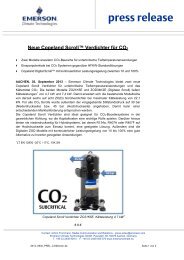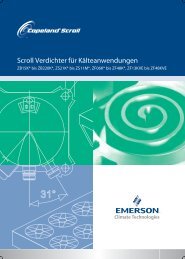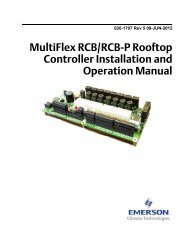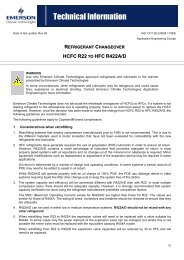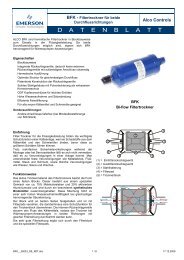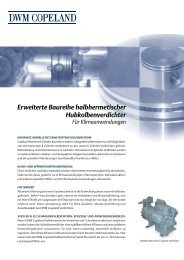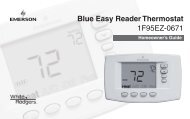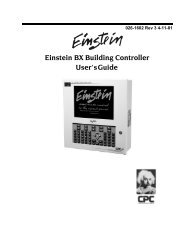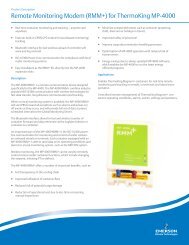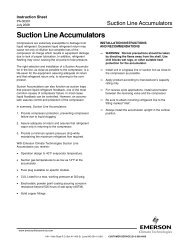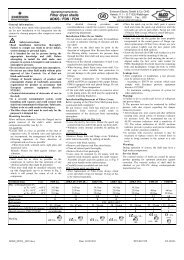E2 User Manual.book - Emerson Climate Technologies
E2 User Manual.book - Emerson Climate Technologies
E2 User Manual.book - Emerson Climate Technologies
Create successful ePaper yourself
Turn your PDF publications into a flip-book with our unique Google optimized e-Paper software.
outside and inside temperature to monitor supply and<br />
return air temperature. When used in this application, the<br />
sensors are supplied without enclosure covers. The sensors<br />
should be mounted directly in the air stream of the supply<br />
or return air duct. The sensors are not supplied with any<br />
mounting hardware for this application.<br />
3.5.6 Refrigeration System Temperature<br />
Probes and Sensors<br />
3.5.6.1 Location<br />
Retail Solutions supplies several temperature monitoring<br />
devices including bullet sensors, pipe mount sensors,<br />
immersion probes, insertion probes, and sensors for high<br />
temperature applications. Each of these sensors is generally<br />
installed on the system by the equipment manufacturer.<br />
If a device must be added to the system, refer to the<br />
information supplied with the device and consult the<br />
refrigeration equipment manufacturer. Table 3-1 lists some<br />
typical sensor applications and the sensor or probe most<br />
suited for that purpose.<br />
Application Sensor Type<br />
Condenser Outlet (Drop Leg) High Temperature Bullet<br />
Liquid (Manifold) Pipe Mount<br />
Suction Temperature Pipe Mount<br />
Discharge Air Bullet<br />
Ambient Temperature (Outside) Bullet<br />
Condenser Sump Insertion Probe<br />
Defrost Termination Bullet<br />
Table 3-1 - Sensor Application and Type<br />
3.5.6.2 Mounting Bullet and Pipe Mount<br />
Sensors<br />
Bullet or pipe mount sensors mounted on refrigerant<br />
lines should be secured with a Panduit low temperature<br />
cable tie, number PLT2S-M120, or equivalent. For pipe<br />
mount sensors, the curved surface should be placed<br />
against the pipe and the tie should be positioned in the<br />
groove on the top surface of the sensor. A second tie<br />
should be used to secure the lead to the pipe for additional<br />
support.<br />
Sensors located on refrigerant lines should be insulated<br />
to eliminate the influence of the surrounding air. A selfadhering<br />
insulation that will not absorb moisture is recommended<br />
to prevent ice logging at the sensor location.<br />
The sensor should be positioned on the side of the line<br />
as shown in Figure 3-24.<br />
Figure 3-24 - Sensor Orientation<br />
3.5.7 Product Temperature<br />
Probes<br />
The product temperature probe is designed to be used<br />
alongside food products in a refrigeration case or freezer.<br />
The product probe uses a thermistor type temperature sensor<br />
in a sealed, cylindrical container (approximately 16<br />
oz.). A magnet is contained at the bottom the probe’s<br />
enclosure to allow easy attachment to a side or bottom of a<br />
refrigeration case.<br />
3.5.8 Humidity Sensors and<br />
Humidistats<br />
3.5.8.1 Indoor RH Sensor<br />
The indoor relative humidity sensor should be<br />
mounted in a central location within the zone to be measured,<br />
away from doors, windows, vents, heaters, and outside<br />
walls that could affect temperature readings. The<br />
sensor should be between four and six feet from the floor.<br />
Note that this sensor generates a small amount of heat;<br />
therefore, do not mount temperature sensors directly<br />
above RH sensors.<br />
Mount RH sensor (P/N 203-5751) as follows:<br />
1. With a flat-head screwdriver, push down the<br />
middle tab on the top of the sensor case and<br />
pop the lid off to expose the circuit board.<br />
2. Insert the flat-head screwdriver into the two<br />
slots on either side of the top of the sensor<br />
case and twist to separate the back plate from<br />
the case.<br />
3. Remove the knock-outs from the back plate<br />
before mounting so wires may be threaded<br />
through.<br />
Sensors and Transducers Mounting • 3-9



